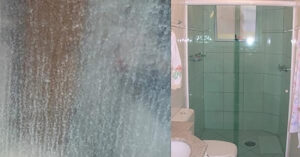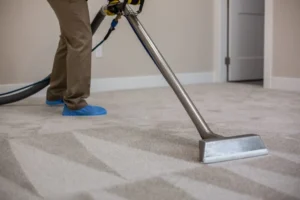Depending on where your home is located, your water could be categorized as hard or soft. Hard water doesn’t feel “hard,” and soft water doesn’t feel “soft,” so what’s the difference and how can you tell? Water hardness or softness refers to the concentration of minerals like lime (aka limescale), calcium, and magnesium found in your home’s tap water.
The water that comes out of your faucet travels a long way to get to your home and picks up traces of underground minerals as it passes through layers of rock. Due to these higher mineral deposits, hard water tends to adhere to glass, dishes, sinks, and bathtubs than soft water, causing stains. It can even damage plumbing, water heaters, porcelain, and glass.
That’s why if your home has hard water, it’s a good idea to learn about removing hard water stains in your bathroom and kitchen. While hard water isn’t a health concern or safety issue for you and your family, it can be a nuisance if you don’t know how to remove hard water stains. To learn what hard water looks like and how to remove the stains, follow along with Top to Bottom House Cleaning field-tested easy processes below.
What Do Hard Water Stains Look Like?
How do you know if you have hard water? Here are a few signs of high levels of mineral content:
• A film on your hands after washing dishes or on your body after taking a bath could be a sign of hard water. The film results from soap reacting with the calcium in your water to create what most of us call soap scum.
• Hard water can leave spots on glassware, silverware, and dishes after they are washed in your dishwasher. The culprit here is calcium carbonate, and it can stain and even etch glass.
• Unexplained stains on your laundry could be coming from the minerals in hard water. Because of minerals’ abrasiveness, they can also cause unnecessary wear and tear on clothes each time you wash them.
• Low water pressure could be caused by faulty plumbing or a local water pipe bursting, but it could also be caused by hard water. Mineral deposits build up inside your water pipes, and the smaller waterway reduces water flow.
• Dark red or brown stains in a toilet, sink, or tub can occur because of high iron levels found in some hard water.
White scale from calcium or magnesium is probably the most common hard water stain. If you see cloudy or foggy patches on glass shower doors, the culprit is almost always the minerals from hard water.
How to Remove Hard Water Stains From Glass
Even if you clean like a pro, you still need to know how to remove hard water stains from a shower. Regularly cleaning your shower doors will help keep limescale at bay, but it’s best to be on the lookout for new hard water stains before they get too bad. You can also use these cleaning solutions to remove hard water from tile and other non-porous surfaces.
Salt And Water
• Mix a paste with table salt and water.
• Use a microfiber cloth to rub the paste onto the stains.
• Scrub firmly until the cloudiness disappears.
• Wipe the stained area with a clean, damp cloth.
• Dry the glass with paper towels.
Distilled White Vinegar And Lemon Juice
• Mix equal parts lemon juice and distilled white vinegar in a spray bottle.
• Spray the vinegar and lemon juice stain remover on the stain.
• Let the cleaning solution work on the stain for about five minutes.
• Use a microfiber cloth to rub the stained area until the stain is gone.
• Rinse the area with a clean camp cloth.
• Dry the glass.
If you water your lawn and have hard water, the minerals can stain and etch your exterior window glass. You can use either of the cleaners above to remove hard water stains, but you’ll want to have your windows cleaned first.
STEEL WOOL
scrub steel wool and soap it’s magic!!!
www.toptobottomhousecleaning.com







